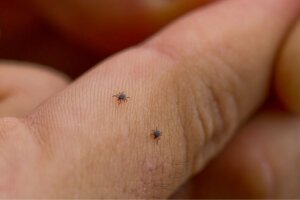How to Prevent Lyme Disease

Lyme disease is an infectious disease of bacterial origin that occurs when affected ticks bite. It’s associated with multiple long-term skin, systemic, joint, and cardiovascular problems. Are you interested in learning how to prevent Lyme disease? Below, we’ll tell you.
Currently, the spirochete Borrelia burgdorferi is recognized as the pathogen responsible for the disease. Research affirms that this is one of the most frequently diagnosed pathologies caused by ticks worldwide.
How is Lyme disease spread?
The main vectors involved in the pathogenesis of Lyme disease are ticks. However, not all ticks participate in transmission. Studies suggest that mites of the genus Ixodes are the vectors with the highest transmission rate of borreliosis.
Female ticks lay millions of eggs per year, which hatch to feed on the blood of small rodents. They then become nymphs and adults that continue to consume the blood of animals, acquiring Borrelia spp. The main hosts for these vectors in Europe and the United States are mice and deer.
People generally become infected by exposure to these vectors or their hosts in wooded areas, humid areas, and grasslands, especially during the summer. At the same time, the tick must remain attached to the skin’s surface for a minimum of 24 to 36 so that the germs can be successfully inoculated into the blood.
Measures to prevent Lyme disease
In most cases, infectious diseases transmitted by insects can be avoided by curbing exposure and maintaining a proper habit of body hygiene. Some measures that can be used to prevent Lyme disease include the following.
Avoid tick-infested areas
The risk of exposure to mites is greatest in wooded areas or those covered with tall grass or bushes. Similarly, they can be found both on lawns around your home and in parks.
For this reason, it’s essential that you stay within the trails and avoid entering areas with unpruned bushes and grass. What’s more, it’s important to maintain an adequate distance from all those animals that can serve as hosts for the vectors, such as mice and deer.

Use repellants and pesticides
Using repellants on clothing and shoes greatly reduces the risk of tick bites. The use of repellants with 20 to 50% N, N-diethyl-meta-toluamide (DEET) is recommended on skin and clothing.
Similarly, lemon eucalyptus oil (LEO), para-menthane-diol (PMD), and 2-undecanone are useful repellants to prevent Lyme disease. However, these substances can cause side effects on the skin, such as irritation and stinging. In addition, the use of LEO and PMD is contraindicated in children under 3 years of age.
Some studies claim that permethrin is another effective substance for the elimination of mites. This must be applied previously on clothes and shoes in an open environment. In addition, its application on the skin should be avoided and medical attention should be sought as soon as possible in case of the appearance of any strange symptom.
On the other hand, acaricides are pesticides that can be used around the home in order to reduce peridomiciliary tick populations. Experts recommend applying it in late spring or early summer.
Hygiene and the removal of ticks
Proper body hygiene is vital when exposing yourself to areas with a high risk of infection or when doing outdoor activities. For this reason, it’s a good idea to examine your skin and clothing at least once a day for ticks that may be attached. Hot, humid areas such as the armpits, belly button, groin, buttocks, and scalp should be closely checked.
If you find mites on the skin, you should be calm and try to eliminate them as soon as possible. To do this, small tip tweezers and gloves are usually used, avoiding direct contact with the vector.
Once the tick has been extracted, you must verify that it’s complete and that no material remains attached to the skin. In addition, it’s important to maintain proper care depending on the type of skin in order to stay healthy and avoid short-term side effects.
The following tips should be followed when removing these tiny mites from the body:
- Don’t try to suffocate the tick with petroleum jelly, oil, or other substances.
- Avoid crushing or twisting the tick when pulling it.
- Don’t remove it if your skin is bare and unprotected.
- Avoid applying direct heat to the mite.
Similarly, a shower and plenty of shampoo can help eliminate ticks by dragging them away. At the same time, clothes and shoes have to remain in the dryer at a high temperature for at least 10 minutes to kill the vectors that remain hidden in the dry clothes when entering the home.
Check pets
Pet fur forms the ideal habitat in order for mites to enter the home. For this reason, an effective way to prevent Lyme disease is to carefully inspect pets before entering the house.
In most cases, the ticks can be on the animal’s skin without biting it and then move onto human clothing. In the event that the pet has several attached ticks, the same indications should be followed as when removing them from human skin.

Create a tick-free environment
Ticks generally can’t survive in sunny, dry areas. In addition, the American Lyme Disease Foundation (ALDF) states that these vectors can’t jump or fly, so they require direct contact with the host.
With this in mind, it’s a good idea to apply the following measures around the home:
- Mow your lawn regularly
- Clean the edges of paths
- Place wood chips or gravel as a border between the garden and wooded areas
- Check and clean pet feeders
- Position outdoor activity equipment or objects away from bushes and trees
Reducing exposure to ticks is the main protective factor
The prevention of Lyme disease is based on reducing exposure to the ticks responsible for inoculating the bacteria Borrelia spp. In this sense, it’s crucial that you pay special attention to body hygiene and clothing cleanliness when carrying out any outdoor activity.
At the same time, ticks require more than 24 hours to transmit the disease. Therefore, finding these small insects on the skin doesn’t indicate that the infection has already been inoculated. It’s important to monitor the surface where the bite occurred and to seek professional help for any strange symptoms.
Lyme disease is an infectious disease of bacterial origin that occurs when affected ticks bite. It’s associated with multiple long-term skin, systemic, joint, and cardiovascular problems. Are you interested in learning how to prevent Lyme disease? Below, we’ll tell you.
Currently, the spirochete Borrelia burgdorferi is recognized as the pathogen responsible for the disease. Research affirms that this is one of the most frequently diagnosed pathologies caused by ticks worldwide.
How is Lyme disease spread?
The main vectors involved in the pathogenesis of Lyme disease are ticks. However, not all ticks participate in transmission. Studies suggest that mites of the genus Ixodes are the vectors with the highest transmission rate of borreliosis.
Female ticks lay millions of eggs per year, which hatch to feed on the blood of small rodents. They then become nymphs and adults that continue to consume the blood of animals, acquiring Borrelia spp. The main hosts for these vectors in Europe and the United States are mice and deer.
People generally become infected by exposure to these vectors or their hosts in wooded areas, humid areas, and grasslands, especially during the summer. At the same time, the tick must remain attached to the skin’s surface for a minimum of 24 to 36 so that the germs can be successfully inoculated into the blood.
Measures to prevent Lyme disease
In most cases, infectious diseases transmitted by insects can be avoided by curbing exposure and maintaining a proper habit of body hygiene. Some measures that can be used to prevent Lyme disease include the following.
Avoid tick-infested areas
The risk of exposure to mites is greatest in wooded areas or those covered with tall grass or bushes. Similarly, they can be found both on lawns around your home and in parks.
For this reason, it’s essential that you stay within the trails and avoid entering areas with unpruned bushes and grass. What’s more, it’s important to maintain an adequate distance from all those animals that can serve as hosts for the vectors, such as mice and deer.

Use repellants and pesticides
Using repellants on clothing and shoes greatly reduces the risk of tick bites. The use of repellants with 20 to 50% N, N-diethyl-meta-toluamide (DEET) is recommended on skin and clothing.
Similarly, lemon eucalyptus oil (LEO), para-menthane-diol (PMD), and 2-undecanone are useful repellants to prevent Lyme disease. However, these substances can cause side effects on the skin, such as irritation and stinging. In addition, the use of LEO and PMD is contraindicated in children under 3 years of age.
Some studies claim that permethrin is another effective substance for the elimination of mites. This must be applied previously on clothes and shoes in an open environment. In addition, its application on the skin should be avoided and medical attention should be sought as soon as possible in case of the appearance of any strange symptom.
On the other hand, acaricides are pesticides that can be used around the home in order to reduce peridomiciliary tick populations. Experts recommend applying it in late spring or early summer.
Hygiene and the removal of ticks
Proper body hygiene is vital when exposing yourself to areas with a high risk of infection or when doing outdoor activities. For this reason, it’s a good idea to examine your skin and clothing at least once a day for ticks that may be attached. Hot, humid areas such as the armpits, belly button, groin, buttocks, and scalp should be closely checked.
If you find mites on the skin, you should be calm and try to eliminate them as soon as possible. To do this, small tip tweezers and gloves are usually used, avoiding direct contact with the vector.
Once the tick has been extracted, you must verify that it’s complete and that no material remains attached to the skin. In addition, it’s important to maintain proper care depending on the type of skin in order to stay healthy and avoid short-term side effects.
The following tips should be followed when removing these tiny mites from the body:
- Don’t try to suffocate the tick with petroleum jelly, oil, or other substances.
- Avoid crushing or twisting the tick when pulling it.
- Don’t remove it if your skin is bare and unprotected.
- Avoid applying direct heat to the mite.
Similarly, a shower and plenty of shampoo can help eliminate ticks by dragging them away. At the same time, clothes and shoes have to remain in the dryer at a high temperature for at least 10 minutes to kill the vectors that remain hidden in the dry clothes when entering the home.
Check pets
Pet fur forms the ideal habitat in order for mites to enter the home. For this reason, an effective way to prevent Lyme disease is to carefully inspect pets before entering the house.
In most cases, the ticks can be on the animal’s skin without biting it and then move onto human clothing. In the event that the pet has several attached ticks, the same indications should be followed as when removing them from human skin.

Create a tick-free environment
Ticks generally can’t survive in sunny, dry areas. In addition, the American Lyme Disease Foundation (ALDF) states that these vectors can’t jump or fly, so they require direct contact with the host.
With this in mind, it’s a good idea to apply the following measures around the home:
- Mow your lawn regularly
- Clean the edges of paths
- Place wood chips or gravel as a border between the garden and wooded areas
- Check and clean pet feeders
- Position outdoor activity equipment or objects away from bushes and trees
Reducing exposure to ticks is the main protective factor
The prevention of Lyme disease is based on reducing exposure to the ticks responsible for inoculating the bacteria Borrelia spp. In this sense, it’s crucial that you pay special attention to body hygiene and clothing cleanliness when carrying out any outdoor activity.
At the same time, ticks require more than 24 hours to transmit the disease. Therefore, finding these small insects on the skin doesn’t indicate that the infection has already been inoculated. It’s important to monitor the surface where the bite occurred and to seek professional help for any strange symptoms.
- Skar GL, Simonsen KA. Enfermedad de Lyme. En: StatPearls. Treasure Island (FL): StatPearls Publishing; 2021 enero-.
- Herrera Lorenzo O, Infante Ferrer J, Ramírez Reyes C, Lavastida Hernández H. Enfermedad de Lyme: historia, microbiología, epizootiología y epidemiología. Rev Cubana Hig Epidemiol. 2012; 50( 2 ): 231-244.
- Grear J, Koethe R, Hoskins B, Hillger R et al. The effectiveness of permethrin-treated deer stations for control of the Lyme disease vector Ixodes scapularis on Cape Cod and the islands: a five-year experiment. Parasites & Vectors. 2014; 7(1): 292.
- Eisen R, Eisen L. The Blacklegged Tick, Ixodes scapularis : An Increasing Public Health Concern. Trends in Parasitology. 2018;34(4):295-309.
- Jones E, Hinckley A, Hook S, Meek J et al. Pet ownership increases human risk of encountering ticks. Zoonoses and Public Health. 2017;65(1):74-79.
- InformedHealth.org. Colonia, Alemania: Instituto de Calidad y Eficiencia en la Atención de la Salud (IQWiG); 2006-. Picaduras de garrapatas: ¿Qué son las garrapatas y cómo se pueden eliminar?.
Este texto se ofrece únicamente con propósitos informativos y no reemplaza la consulta con un profesional. Ante dudas, consulta a tu especialista.







